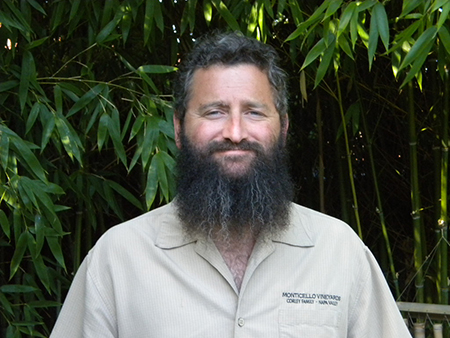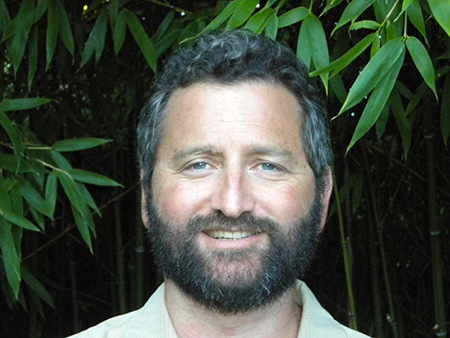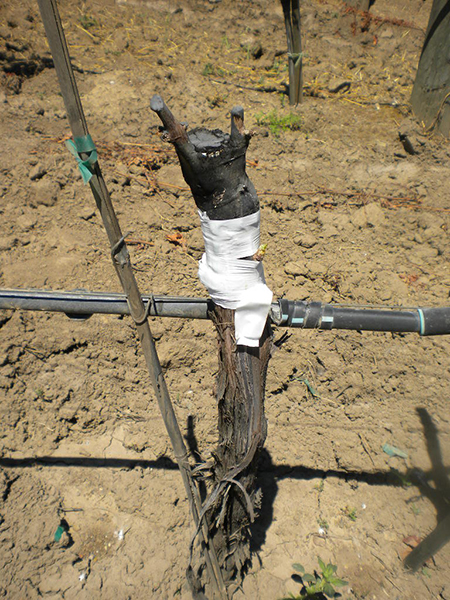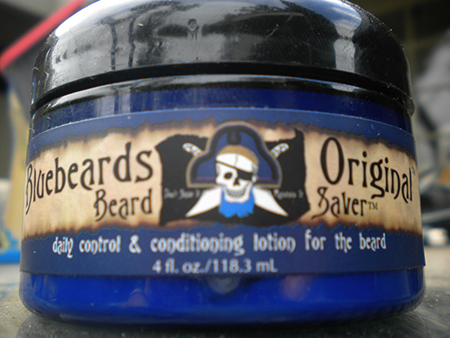Planting For The Future & Walking Back Through Time
Posted By : Chris Corley
When I was a kid (well at least when I was a younger one than the one I am now), I used to like going to the vineyard with my dad. We lived in St. Helena and the vineyards are just north of Napa, so there was always a little bit of drive to get there. Back then, the drive from St. Helena to Napa kind of seemed like a big deal and the eucalyptus trees along Highway 29 just south of Yountville were always a marker for me for some reason that would only make sense to a kid riding along with his dad.
Back then the vines seemed huge to me, and indeed they were. Grown in the old school California sprawl, the shoots were incredibly vigorous and created a tangle of huge leaves and tendrils that would stretch across the wide rows and intertwine with each other. The strength of those tendriled bonds was undeniable, and it could be a challenge for a kid to work his way through a tangled row.
Most vineyards don’t look like that anymore. They’re much neater, more manicured and tended to with perhaps more precision and the increased knowledge that comes with each additional footprint in the field. I’ve got to say though that I personally have a nostalgic nod towards those old school fields. We grew up around and in them as kids, at least until we got our drivers licenses and our range increased dramatically. Its sort of like looking back at your old pictures and enjoying all the fond memories of the long hair and goofy clothes you used to wear … even though the memories are great, you don’t necessarily want to do it again.
This year, we’re replanting two of our best sites at the front of the property, Blocks I and II. Block I has produced some fantastic Chardonnays over the years. Planted to a clone we refer to as our ‘Heirloom Clone’, which we believe traces its lineage back to the old Wente Borthers selections, the wines had a wonderful balance of ripe fruit, vibrant acidity and a unique musque characteristic that was appealing. As wonderful as the wines were, the block eventually succumbed to a couple of maladies, and replanting became the primary option. We’ll be replanting this block with Dijon Clone 96, a selection that we have had great success with as well on other parts of the property, and we look forward to many years ahead of wonderful Chardonnays again out of Block I.
We are also replanting a portion of Block II, on the northwest corner of the property. In recent years we have been growing Cabernet Franc in this block with great results. We’ve been very happy with the full dark berry flavors, slight nod of pepper and rich firm tannins that we’ve extracted from these grapes. We’re looking forward to the addition of Cabernet Sauvignon in this block. This will be the first Cabernet Sauvignon we’ve grown on the property in decades. When our dad was first transitioning these fields from the previous owners old prune orchard into vineyard land, he had planted some Cabernet Sauvignon in this very block. Convinced by others that it would be too cool to grow great Cab Sauv there, he moved our Cabernet production to the warmer regions upvalley. With the planting of this new block of Cabernet Sauvignon in the same block he had chosen some 30 years ago, he feels somewhat vindicated in that early instinct, and we couldn’t be more excited about what we’re anticipating coming out this block. We’ve chosen Clone 4 Cabernet Sauvignon for this section and are confident that within the next 4-5 years, we’ll be producing a vineyard designated Home Ranch Cabernet Sauvignon to join our three other vineyard designated Cabs from Yountville, Rutherford and St. Helena.
Ironically, I still trudge through the vineyard just like I did when I was a kid. Although then the vines were a tangled jungle taller than me. Now they are a manicured wall of organized shoots. Then the clusters jumbled and hung wherever they wanted (I think this is where the word ‘clusterfuck’ originated!). Now they are neatly positioned along the fruiting wire. Then, like now, we grew grapes and made wine the best way we knew how. Then, like now, we were in awe of this wonderful process. Then we had long hair and the vines were wild-maned. Now we’re trimmed up a bit, and the vines are more manicured. Inside though, its still the same. I still feel like that little kid in the vineyard …
Seasonal Clippings, Vintage Whiskers
Posted By : Chris Corley
I cut off my beard a couple of days ago. Normally the previous years harvest beard would come off the following spring, but this summer has been so cool that the beard remained nearly until this years harvest. Many vintners gauge the growing season by the development of their tomatos in the garden. Seeing how the tomatos grow and ripen can give some an easy visual sense of how the growing season is developing. I'm developing a hypothesis that the degree days of the growing season can be determined by the lifespan of my previous year's Harvest Beard. On the years that I grow a long harvest beard, I find that I can roughly gauge the following growing season by how long the beard lasts into the summer.
My 2009 Vintage Beard lasted until August 2010. This late shearing indicates a cool growing season and a potentially later harvest. The same was true for the 2004 Vintage Beard which came off late in the summer of 2005. This was a late season as well, and coincided with the birth of my daughter Ruby, who along with her one-year old brother Jack, perceived the beard as a plaything and grabbed at it every chance they could. This prompted me to shear perhaps earlier than I normally would have, and perhaps nulls the scientific approach I'd been taking to linking grape development to beard longevity, but it still applies as anecdotal evidence.
My wife and kids have never seen my chin. For that matter, neither have I for the last 18 or so years. I think it's still there. My sons got a dimpled chin, but we're not sure if that came from me or not. I've always had a beard of some length. I've never thought much about why. I guess I'm just enjoying the hair on my head while I've still got it. Gravity affects men too as we age. For me the effect has been that the hair used to grow vigorously upward out of the top of my head, and now grows downward out of my face. My beard tends to grow long in the winter and get sheared in the spring. We've never saved the shearings or tried to fashion textiles out of them, although I suppose that may be the green thing to do. Maybe some day.
Earlier this year I was in Houston doing some wine events and was at a dinner in which some great Spanish wines were shared. At the close of the evening, I gave one of the guests a parting hug. She realized shortly afterward that she had lost one of her rather dangly earrings. We searched briefly for the missing accoutrement, until she realized that her rather dangly earring was hanging in the underbrush of my 2009 Vintage Beard. I thought it looked pretty good, but she wanted it back, so I acquiesced.
We shear the growth in the vineyard as well. We pull lateral shoots and leaves that block the sun and air from getting into the middle of the canopy. We trim excess fruit that may prevent the vine from fully ripening the crop. We trim the weeds and vegetation in the rows and under the vines, so they don't suck up too much of the groundwater or nutrients or create havens for pests.
Sometimes we hack back the vines themselves. This year, we sawed off the tops of a small portion of Cabernet Franc vines in the front block. We grafted Cabernet Sauvignon buds on to these vines. Just two small dormant buds were grafted on to the top of each hacked trunk. They were gooped, taped and we crossed our fingers. This will be the first Cabernet Sauvignon we've grown on the property in about 30 years. We're all pretty excited about the potential. We're hopeful to have a modest crop of Cabernet Sauvignon from this block in 2011, and be fully enagaged in 2012. As a family, we tend to get excited about things that are still years away. Many of these new buds have shown very strong growth in their first season. These two buds per vine have the full force of the already established root system behind them. With this explosive growth, we've already been able to lay down the early shoots to set the cordons for next season.
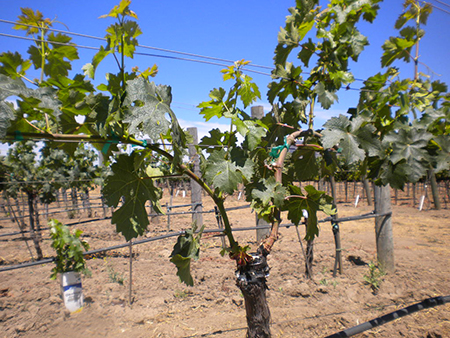
First Years Growth from Two Buds
The root system for the 2010 Vintage Beard is already established as well. I'll need to order a new tub of Bluebeard's Original so I'll be ready for the potentially explosive whisker development this harvest
The Grapes Don't Fall Far From The Vine ...
Posted By : Chris Corley
When our Dad, Jay, started Monticello Vineyards in the late 1900s, he grew and sold grapes. The land that he purchased in 1969 was and old decrepit prune orchard, which he tore out and replanted to grapevines. Over the last 40 or so years, we've grown a lot of different types of grapes on the property. In the early days, we sold all of the fruit that we grew to other wineries. It wasn't until we built the winery in 1980 that we began to make our own wines and would keep a certain amount of fruit for our own winemaking needs. To this day, we continue to sell premium grapes to other well-regarded wineries throughout the Napa Valley for use in their winemaking programs.
Around this time of year, we get together with the winemakers that we sell grapes to so we can taste through and compare notes about the wines that they and we have respectively made from our grapes. It's a great way for us to keep in contact with our customers and exchange ideas and notes about the previous harvest. We'll compare and contrast winemaking techniques, look ahead to the next growing season and talk about any adjustments or improvements we would like to collectively make.
Just as tending to the field ensures that we'll grow the best grapes we can, cultivating our relationships promotes communication and better opportunities for all that are involved. Over the last month or so, my brother Kevin and I have been rolling around the valley visiting and tasting with our grape customers, tasting through their wines and sharing ours.
It is always interesting to taste two wines, made by two different winemakers from the same grapes. There are generally themes in the wines, especially when we taste wines from particularly expressive sites. These themes are usually oriented around particular or unique flavors or aromas that we would associate with that site. The winemakers hand also plays a large role in the wine. Certain fermentation techniques will lend themselves to wines of varying tannin levels, for instance.
Our family has always gravitated towards the open-minded and easy-going in the industry, and these types of winemakers are usually the most enjoyable to spend time tasting with. It's the open sharing of ideas that promotes creative thinking and helps us to continually improve our skills as winemakers and winegrowers ...
New Year , New Season
Posted By : Chris Corley
This week we’ve started pruning. Pruning is much more than just hacking back last years growth, it’s a critical step in setting the vine up for the growing season. Pruning can affect the training of the vine, suggest a general cropload for the season, and perhaps even influence the timing of budbreak. It is the most immediately visually altering step that we take in the vineyard, and the dramatic shift in the panorama from the 4-6 foot canes to 2-3 inch spurs really reminds you that we’re shifting gears in the field. Once pruned and perhaps disced or mowed, the vineyard is about as bare as you will see it all year. But there is a kind of simple beauty in that naked vineyard. It allows you to see the gentle undulations and soil variations that may be difficult to perceive through a growing canopy.
A lot of the time, we speak of pruning as being the beginning of the growing season for the vines. In reality, this growing season began as soon as we harvested last years grapes (2008). When the vines are relieved of their crop and sometimes still have some green leaves, the chlorophyll in those leaves are still actively doing photosynthesis. Not much (because its late fall) but this photosynthesis is important. Because there is no more fruit to ripen, this post-harvest energy is stored, and this is what can help the vine to get started back up again in the spring at budbreak. Many growers will even be sure to give their vines a post-harvest “feed”, while the vines are still somewhat active in feeding and transpiration.
Chlorophyll and compost aside, pruning is an exciting time. To watch a 2-inch spur develop throughout the year into a lengthy elegant shoot with wispy tendrils and and beautiful clusters is a joy I look forward to each year. For now it is a pleasure to watch the vineyard be slowly transformed into its most basic and pure state …
Red, Yellow and Green Lights
Posted By : Chris Corley
This has been a very interesting growing season. As an industry, we had one of the worst frost seasons in recent history, then a mild summer with some very intense heat spikes and then another cool spell through September. Aside from the damage and crop reduction caused by the frost throughout the valley, this year's crop is lighter than usual. We're seeing people scrambling for fruit, and its years like this that help remind us how fortunate we are to be growing most all of our own grapes (and also how fortunate we are to have a kick-ass sprinkler system and a guy named Angel to protect every last one of our grapes from the bitter cold).
Most growing seasons you don't have a map. You know where you want to go, but there's a lot of variables that prevent you from just charting your course in the spring. It would be like pulling out your map, except that they keep rebuilding the streets and putting up detours as you're driving so the map isn't really valid anymore after you start your trip. So we don't use a map. It's more like navigating with a globe, except you've got stoplights to monitor the traffic.
In the beginning of a growing season you can see where you are when you get started, and we know from experience where we want to be at the end. The variable is all the stuff that happens in the meantime. Most of the variable is the weather, but if you've got a solid starting point and destination, you'll know how to react to the variables when they strike. You must simultaneously be immersed in the minutiae and also grant yourself a necessary distance from the details to be able to see where you are. This is like navigating a globe but with stoplights.
Thomas Jefferson had a penchant for finding the highest point in any new place or city that he visited. It gave him a broader perspective of a new locale. He governed in much the same way, granting himself a 'necessary distance from the details' in order to maintain a broader perspective. This was effective for him because he had other people delegated to sweat the small stuff. We need to do both ourselves.
When growing grapes for wine, we need to be looking down the field, and to do that you need the highest perch you can find. Literally, that is sometimes standing on the roof of the winery or utilizing aerial photography. We also pay attention to the stoplights. A vine's stoplight system also kind of works on Red, Yellow and Green but in slightly different ways. When we sample our grapes, the taste and texture of the fruit override most all other factors. We also run numbers in the lab to establish metrics. Sometimes the fruit tastes great and the numbers look good, and one may be inclined to pick.
That's when we need to pull out our globe and check the stoplights. From our perch, we can see where we are on our journey and how the road looks ahead - will it be hot, dry, cold, rainy ? The color of the vines leaves are our stoplights and can indicate to us the ability of the vine to continue down the road. If the leaves of the canopy are very green and the road ahead looks mild - go (in this case 'go' means keep hanging the fruit). If the leaves are yellow, pay close attention - the vine may be shutting down. If the leaves are red, odds are the vine has a virus, and you'll want to stop and pay close attention to those vines.
Although we don't get tickets in the field when we run lights, you'll know whether we were paying attention while we were driving each growing season. In light of recent legislature in California, we'll be assessing after this year if we need to institute a policy of not using a cell phone while we're in the field ...
Seasons
Posted By : Chris Corley
This past Monday our two children, Jackson (4) and Ruby (3), started the schoolyear. Jack was happy to be back for his second year and see his teacher and friends again. Ruby was excited for her first year, because now she's a 'big girl' and can go to school with Jackson. After we dropped them off, I got to thinking about what a beautiful time of year this is, for different reasons than I have in the past.
I've basically lived my whole life in Napa Valley, and this time of year has always represented the frenetic culmination of the growing season. The sticky bins of grapes and invigorating sensation of thrusting your arms into a tub of fermenting red grapes, the yelps from the field as the pickers banter in fieldsong, the somewhat appealing aromatic blend of diesel fumes and dirt as the tractors crawl through the field.
For my whole life, these sensations have signalled to me the end of a season. As each block of fruit gets harvested, that block begins to slowly yellow, the leaves will eventually fall off, and the vine will fall into a dormant slumber awaiting its budbreak the following spring. Harvest is the end of red carpet for that block for the year. All the attention and tending-to and primping the vines have enjoyed will be largely over until the crew returns in the spring to manicure the canes.
When we dropped Jackson and Ruby off, I realized that for them - this time of year is an exciting new beginning. It is the inspiring trailhead of a great new adventure with their teachers and friends. They will learn new lessons, make new friends, make mistakes and learn from them, have successes and revel in them.
The smiles on their faces and the excitement in their voices this whole past week could nourish me for a lifetime. My children have taught me that this time of year is also a beginning not just a finale. The smell of diesel, dirt and grapes has never been so sweet ...
Turning Colors
Veraison ! Right now is an exciting time in the vineyard. Some of the grapes are going through that magical metmorphosis called veraison, when the berries begin to soften up and change colors. The white grapes transform from tart, bright green pellets into soft luscious golden grapes and the red grapes drift through every shade imaginable between lime green and deep purple. It is really amazing to watch. When I figure out how to post pictures on the blog, I'll be sure to include a picture of a cluster mid-veraison.
As different varietals all have their own timelines, they go through veraison at different times. As of today, our Pinot Noir is about 40-50% through, the Chardonnay about 50-60% through and the Syrah roughly 10-15% through. For me, putting a percentage on veraison is really a peripheral observation, made mostly by walking through the blocks and taking a broadview of the clusters and getting a sens of about how many berries on the cluster have turned color. A little easier to see with the red grapes. With the whites, it takes a little squeezing to see if the cluster is softening up.
Today we were removing leafs and pulling excess shoots to expose the fruit to more clusters. Just like mowing your lawn, you can smell the vegetation as it gets cut from the vine - in this case, like fresh cut grass and bell peppers.
The vibe picks up when the berries start turning color, and the guys in the field and in the cellar are definitely buzzin' with harvest around the corner ...
Bowlcut or Mohawk ?
Posted by : Chris Corley
My wife, Julianna, and I have two wonderful kids - Jackson (4) and Ruby (3). Over the years, I've performed my share of haircuts. I'm not always so hip on current trends, so when it comes to decision making at the shearing table, my internal compass seems to quiver between bowlcuts and mohawks.
These same decisions apply when its time to groom our vineyards. How we tend to the rows between the vines can be as important as how we tend to the vines themselves. In general, there a few different techniques for tending to the rows, most everything else is a variation on a theme ...
1. Leave the soil as is and mow down the natural cover crop - the natural grasses and weeds.
2. Disk the soil, turning it over to break up the dirt.
3. Plant a specific cover crop (specific grasses or legumes) to accomplish a specific objective - i.e. to "drink" excess groundwater, or to replenish the soil with nitrogen, etc.
Sometimes the rows are treated uniformly, meaning that we would till every row in a given block of grapes, or we would grow a cover crop in every row.
In other blocks, we alternate cover-cropped rows with disked rows. It depends on the soil in the block, the vigor of the vines, the amount of rainfall through the winter, and which direction their internal compasses swing when Kevin and Angel are in the field.
By the way, I've never actually pulled out the salad bowl for the kids, but I'm reserving the right to scalp them with a mohican if there's any funny business !
The Frost of 2008
Posted By : Chris Corley
Every now and then, natural circumstances conspire to remind us of our place in the order of things. This year, Mother Nature has collaborated with Jack Frost to inflict upon us one of the harshest frost seasons in perhaps the last 30 years. Certainly the coldest I can recall, although our Dad will have 'fond' memories of farming challenges all the way back to 1970.
Frost season can be exhausting for the guys in the field who have to monitor the cold temperatures closely in order to protect the fragile young shoots. Our vineyard manager, Angel Avina, who has been with us better than 20 years has spent many a cold lonely night this season in the vineyard watching the mercury drop and determining just the right time to either fire up the wind machines or crank up the pumps in the pumphouse for the sprinklers.
In general, the sprinklers are a more effective method of combating the cold, as there is a constant supply of fresh water applied to the vines, which keeps the vines at a cool 32F or so as the water continually rotates through freeze/thaw cycles. Wind machines work by moving the air throughout the vineyard and pulling down the warmer air layer to keep the green shoots from freezing.
Thanks to Angel's valiant efforts, we've experienced little to no damage in our vineyards under sprinkler. We did suffer a little frost damage on the perimeters of our wind-machine protected vineyards. While this won't impact the quality of the fruit we bring in (we'll isolate any affected vines), it will decrease our crop a bit.
At the end of the day, another reminder of whose ultimately calling the shots and also that as winegrowers, we're essentially glorified farmers whose primary responsibility is to navigate the growing season and guide our crop into the barn as safely as we can ...
